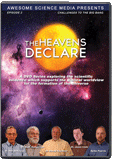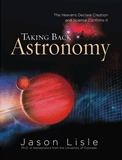What About the Big Bang?
Even the Idea that the Universe Is Expanding Is Under Attack by Some Astronomers.
Originally published in Creation 20, no 3 (June 1998): 42-44.
In his book, A brief history of Time, the well-known British physicist, Stephen W. Hawking, identifies the ultimate question behind everything. 'Today we still yearn to know why we are here and where we came from.'1
In the last chapter of his book he says:
'We find ourselves in a bewildering world. We want to make sense of what we see around us and to ask: What is the nature of the universe? What is our place in it and where did it and we come from? Why is it the way it is?'2
Hawking concedes that the important question of why the universe exists cannot be answered by means of equations and theories.
'Even if there is only one possible unified theory, it is just a set of rules and equations. What is it that breathes fire into the equations and makes a universe for them to describe?'3
Nevertheless, he concludes his book by limiting himself to the equations, instead of looking for their Author.
'However, if we do discover a complete theory, it should in time be understandable … by everyone, not just a few scientists. Then we shall all … be able to take part in the discussion of the question of why it is that we and the universe exist. If we find the answer to that, it would be the ultimate triumph of human reason-for then we would know the mind of God.'4
Like so many other astronomers and physicists, Hawking tries to explain the universe without acknowledging its Creator. But Isaac Newton (1642-1727), possibly the greatest physicist of all time, and a predecessor of Hawking in the same chair at Cambridge University, firmly believed that the solar system was created by God.
The idea that the solar system emerged from a swirl of matter began with Immanuel Kant (1724-1804). Many present-day cosmologists describe the cosmos in terms of evolutionary development and most of them accept the so-called big bang theory.
According to this theory, the universe began about 10 to 20 thousand million [10-20 billion-Ed.] years ago as an inconceivably small volume of space (or a single point of vast energy) which has been expanding ever since. The most important observation supporting the concept of an expanding universe is the 'red shift' of light from distant stars.
This inferred expansion cannot be observed directly, but light coming from distant galaxies seems to have longer wavelengths (i.e. gets 'redder') as the distance increases. This is attributed to either the Doppler effect (that the wavelengths of light are 'stretched out' when galaxies move away from one another) or the relativistic stretching of the space between the stars as the universe expands. The big bang theory suggests that the cosmos was originally compressed into a hot and dense 'cosmic egg,' and as the universe aged, it expanded.
Many discoveries made in recent years with improved instruments and improved observational methods have repeatedly shaken this theory.
Space does not permit a full discussion of the evidence for and against the big bang. However, many discoveries made in recent years with improved instruments and improved observational methods have repeatedly shaken this theory.5 Interpretations of the available facts in terms of currently held cosmological models very quickly lead to unresolvable inconsistencies. There is an increasing number of astronomers who raise substantial arguments against the theory.
If the universe came from a big bang, then matter should be evenly distributed. However, the universe contains an extremely uneven distribution of mass. This means that matter is concentrated into zones and planes around relatively empty regions. Two astronomers, Geller and Huchra, embarked on a measuring program expecting to find evidence to support the big bang model. By compiling large star maps, they hoped to demonstrate that matter is uniformly distributed throughout the cosmos (when a large enough scale is considered).
The more progress they made with their cartographic overview of space, the clearer it became that distant galaxies are clustered like cosmic continents beyond nearly empty reaches of space. The big bang model was strongly shaken by this discovery.
It should be added that the visible galaxies do not contain enough mass to explain the existence and distribution of these structures. But the big bang model was not discarded. Instead, the existence of a mysterious, unknown, and unseen form of matter ('dark matter') was postulated. Without any direct evidence for its existence, this 'dark matter' is supposed to be 10 times the amount of visibly observed mass.
A critic of the big bang theory, Ernst Peter Fischer, a physicist and biologist of Constance, Germany, reflects on its popularity. He refers to the:
'… warning given by [physicist and philosopher] Carl Friedrich von Weizsäcker … namely that a society which accepts the idea that the origin of the cosmos could be explained in terms of an explosion, reveals more about the society itself than about the universe. Nevertheless, the many observations made during the past 25 years or so which contradict the standard model, are simply ignored. When fact and theory contradict each other, one of them has to yield.'6
Another critic of the big bang theory, Halton C. Arp, was attached to the world-famous Mount Wilson Observatory near Pasadena, USA, and to the Las Campanas Observatories in California. He explains the reasons for rejecting the big bang model in a notable article, 'Der kontinuierlicher Kosmos' (The continuous cosmos).
'Since antiquity, ideas of the universe have varied widely, depending on assumptions about factual observations. The current idea of a big bang has been the standard model for about 60 years. But, in the mean time, the number of observations that negate the assumption that the red shift of the light of distant galaxies can be explained by recessive motions, is increasing.'7
In other words, even the idea that the universe is expanding is under attack by some astronomers.
Arp continues his criticism of the big bang theory and calls for it to be rejected by the scientific community.
'In my opinion the observations speak a different language; they call for a different view of the universe. I believe that the big bang theory should be replaced, because it is no longer a valid theory.'8
Professor Hans Jörg Fahr of the Institute for Astrophysics at Bonn University, Germany, writes of the demise of the big bang theory in his book, Der Urknall kommt zu Fall (The Demise of the Big Bang).
'The universe originated about 20 thousand million years ago in a cosmic explosion (the big bang), it has been expanding ever since, and it will continue to do so until the end of time … This sounds convincing, and it is accepted by all present-day mainstream “natural philosophers.” But it should be obvious that a doctrine which is acclaimed noisily, is not necessarily close to the truth. In the field of cosmology the widely supported big bang theory is not more convincing than other alternatives. In fact, there are surprisingly many alternatives.'9
Dr James Trefil, professor of physics at Mason University, Virginia, accepts the big bang model, but he concedes that a state of emergency exists regarding fundamental aspects of explaining why the universe exists.
'There shouldn't be galaxies out there at all, and even if there are galaxies, they shouldn't be grouped together the way they are.' He later continues: 'The problem of explaining the existence of galaxies has proved to be one of the thorniest in cosmology. By all rights, they just shouldn't be there, yet there they sit. It's hard to convey the depth of the frustration that this simple fact induces among scientists.'10
It is a great pity that many Christians are willing to 're-interpret' the infallible Word of God to fit a fallible, man-made theory like the big bang. Such ideas are ultimately devised to counter the biblical record, which is firmly against cosmic evolution over billions of years. Those who urge trying to harmonize the big bang with Scripture find it only natural to go on to other evolutionary ideas, such as a 'primitive earth' gradually cooling down, death, and struggle millions of years before the Fall, and so on.
My considered opinion is that as long as we try to explain the universe apart from the Creator and without regard to biblical affirmations given by him, we will continue to be dazzled by a succession of ingenious cosmological ideas, none of which will remotely resemble the truth.11
This article was adapted from Dr Gitt's book Stars and their Purpose: Signposts in Space.
Stars could not have come from the 'big bang'
Evolutionists generally believe that stars formed by the collapse of gas clouds under gravity. This is supposed to generate the millions of degrees required for nuclear fusion.
But most clouds would be so hot that outward pressure would prevent collapse. Evolutionists must find a way for the cloud to cool down. One such mechanism might be through molecules in the cloud colliding and radiating enough of the heat away.
But according to theory, the 'big bang' made mainly hydrogen, with a little helium—the other elements supposedly formed inside stars. Helium can't form molecules at all, so the only molecule that could be formed would be molecular hydrogen (H2). Even this is easily destroyed by ultraviolet light, and usually needs dust grains to form—and dust grains require heavier elements. So the only coolant left is atomic hydrogen, and this would leave gas clouds over a hundred times too hot to collapse.
Abraham Loeb of Harvard's Center for Astrophysics says: 'The truth is that we don't understand star formation at a fundamental level.'1
Reference
- Marcus Chown, 'Let there be light', New Scientist 157(2120):26-30, 7 February 1998.
Footnotes
- S.W. Hawking, A Brief History of Time—From the Big Bang to Black Holes, Bantam Books, New York, U.S.A., p. 13, 1998. See all footnotes
- Ref. 1, p. 171. See all footnotes
- Ref. 1, p. 174. See all footnotes
- Ref. 1, p. 175. See all footnotes
- H.J. Fahr, Der Urknall kommt zu Fall Kosmologie im Umbruc—Franckh-Kosmos Verlag, Stuttgart, Germany, 327 pages, 1992. See all footnotes
- E.P. Fischer (Ed.), Neue Horizonte 92/93—Ein Forum der Naturwissenschaften—Piper-Verlag, München, Germany, pp. 112–173, 1993. See all footnotes
- Ref. 6, p. 113. See all footnotes
- Ref. 6, p. 118. See all footnotes
- Ref. 5, pp. 9–10. See all footnotes
- J. Trefil, The Dark Side of the Universe. Charles Scribner’s Sons, Macmillan Publishing Company, New York, USA, p. 3 and p. 55, 1988. See all footnotes
- See also R. Grigg, The mind of God and the big bang, Creation15(4):38–43, 1993. See also A. Snelling, Galaxy-Quasar ‘Connection’ Defies Explanation, CEN Technical Journal 11(3):254–5, 1994. See all footnotes
Recommended Resources

Answers in Genesis is an apologetics ministry, dedicated to helping Christians defend their faith and proclaim the good news of Jesus Christ.
- Customer Service 800.778.3390
- © 2025 Answers in Genesis





